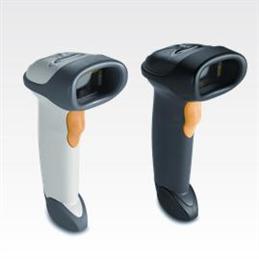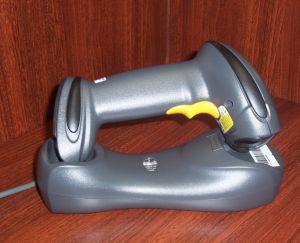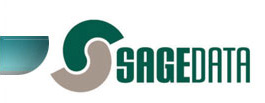The Answer...
Is 1D. For ninety nine percent of applications. But read on, just in case your application is in the one percent category.
Introduction
This page is written for the benefit of those who are considering purchasing a system that uses barcodes, and are trying to decide whether to use the regular single dimension barcodes, or the more two dimensional barcodes that are becoming more common.
Definitions
A 1D or single dimension barcode is comprised of a set of parallel lines on a contrasting background. For best performance this should be black lines on a white background, with a clear white space (the quiet zone) at each end of the vertical lines. The black lines, and the white spaces between them vary in thickness, and data is encoded in the image according the sequence of thin and thick lines and spaces. Common symbologies for 1D barcodes include Code 128, Code 39, EAN, UPC, Interleaved 2 of 5.
A 2D barcode is usually in the form of a square, made up of a mix of smaller black and white squares, somewhat like a chess board with an irregular pattern. The data is stored in the arrangement of the black and white squares. Common symbologies include PDF417 and Datamatrix.
History of the ID Barcode
Human beings are pretty good at recognising shapes. Your great great grandfather needed to be good at recognising a wolf or a sabre tooth tiger, so that he had plenty of time to climb a tree. But he was not very good with time, which is why he was always late for supper. But computers have the opposite skill set. They are awful at recognising shapes, but great with time. So when the first engineers tried to train a computer to read numbers, they were not too successful. Until someone thought of having the computer track time. By shining a light across a series of bars, and watching the reflection, the computer could see a pattern of black and white, like the dots and dashes of Morse code. So by measuring the duration of each reflection, the computer was able to "read" the pattern, and decode the timing to retrieve the numbers stored when the pattern was written. So were the early barcodes brought into being. And this is basically the same one dimensional barcode that is most commonly in use today.
The arrival of the 2D barcode
The one dimensional barcode was adequate for most applications, but for some specific situations there was a need for a barcode with the ability to store more information. The 2D barcode was born. Similar in function to the older one dimensional form but capable of storing more information. The ability to store the Gettysburg address is cited as one example.
factors to be considered in selecting 1-D or 2-D has the preferred format
data content
data content for the 1-D barcode
The information that can be stored in a 1D barcode depends on the symbology used. For most industrial applications the preferred symbology is code 128. With this symbology it is possible to encode the full ASCII character set, which enables numbers as well is alpha characters in upper and lower case. in most industrial applications, the content of the barcode is only used as a key to an entry and a database, in this case for most applications the string of six character provides adequate resolution.
data content for the 2-D barcode
the most significant advantage of the 2-D format is the ability to store larger volumes of data. Because of the compact format it is also possible to provide a greater level of error correction each means that 2-D barcodes can withstand a greater degree of damage before they become unreadable.
the conclusion on data content
although it is true that the 2-D barcode has greater data capacity, it is our experience that in most application is this brings little benefit. So our recommendation in this case would be for a 1-D solution.
Conclusion
In this note our objective was to give you, the reader, an introduction to the topic. Please feel free to browse the rest of this site. The "Learning Centre" section is intended to provide generic information on Barcode Technology and associated disciplines. Other sections of this site provide information on the products and solutions offered by SageData, as well as some information on specific systems that we have designed and implemented.
If you would like further and more detailed information on your specific application, please feel free to call or email with your questions. One of our Inventory Management Experts will be pleased to help you. Enjoy.
For more information...
SageData is based in Ottawa, Ontario, Canada.
We design systems around RFID, Barcodes and Handheld computers.
For further information, contact Doreen Wallace or Keith Jackson.
To reach us by email, click here.
To reach us by phone from Ottawa, dial 613 225 4404
To reach us by phone from outside Ottawa, dial 1-888-838-1067
(c) SageData . Ottawa . Ontario . Canada
QAP









